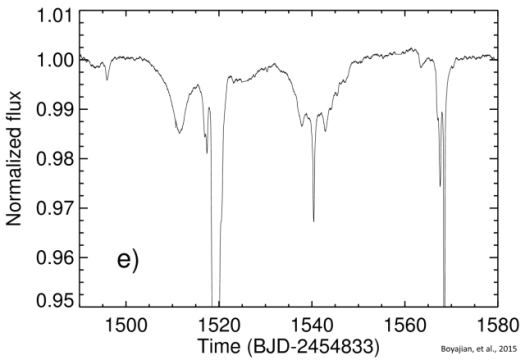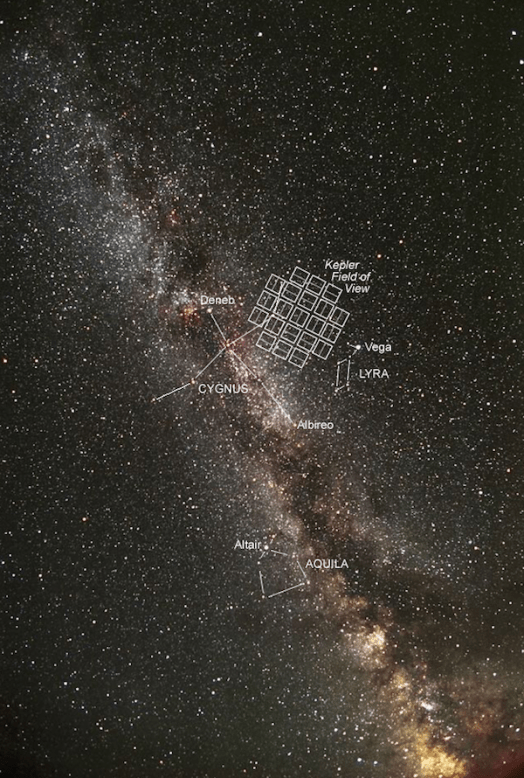
It’s been eight months since citizen “Planet Hunters” working with Yale postdoc Tabetha Boyajian announced the discovery of a most unusual star, or rather a star where something most unusual was intermittently and erratically happening.
The puzzle began with some light curve data, taken over a four year period, by the Kepler Space Telescope The citizen planet hunters pored through reams of data sent back by Kepler looking for signals of planetary transits — the ever-so-slight dimmings of the star caused by the crossing or an orbiting exoplanet.
But the light curve for KIC 8462852 showed dimmings that were anything but slight, and anything but regular. The Planet Hunters flagged the star for Boyajian’s groups attention, and the mystery star was born.
Theories on what was causing the very large dips ranged from a host of enormous comets, to a violently exploding planet, to an asteroid belt or the presence of close by stars, from an artifact of Kepler’s camera to, finally, an alien megastructure. (The last was offered by Penn State astronomer Jason Wright as a kind of “Hail Mary” explanation if and when the others are found wanting. But that’s what got the press.)
Despite years of concerted observing, theorizing and analyzing, Boyajian, Wright the citizen planet hunters and others intrigued by the mystery say they are no closer to an explanation for whatever is passing in front of the star (now informally called “Tabby’s star.”) NASA has ruled out a technical glitch in the Kepler data, and a range of astronomers have found fault with all the explanations put forward.
But while the quite tantalizing mystery remains, efforts to learn more about the star may have to wind down soon. The primary Kepler mission is over, so it will provide no more data for this star. Other space telescopes will not be looking, nor will the major ground-based observatories. And the first SETI searches for signals coming from the star has found nothing unusual.
So with options dwindling to learn more, Boyajian, her citizen astronomers and others have begun a grassroots effort to raise $100,000 to buy time at a network of smaller ground-based telescopes around the world.
“All the models so far have major problem. So to go forward, we need new data ,” Boyajian said this week. “There’s a huge amount of interest in this star, and we’re trying to use that interest to help solve a real mystery.”

KIC 8462852 is an otherwise ordinary F-type star, slightly larger and hotter than our sun . It burns some 1500 light-years away. Of all the 150,000 stars monitored during the Kepler mission, it is the only one to show these kinds of highly unusual light curves and, presumably, to have such massive astrophysical objects (or fields or other phenomena) nearby.
During a TED talk, Boyajian described the recent history of observing the star.
The Planet Hunters, she said, first detected something unusual in the star’s light curve in 2009 –a dip of 1 percent dip that lasted a week. This is roughly comparable to a sign produced by a Jupiter-sized planet transiting the star. Orbiting planets produce symmetric dips and the one they found was definitely asymmetric, like something that could be the result of the passing of an irregularly-shaped object like a comet.
The light from the star remained steady for two years, then it suddenly took a 15 percent plunge that lasted for a week.
Another two years passed without incident but in 2013 the star began flickering with a complex series of uneven, unnatural looking dips that lasted 100 days. During the deepest of these dips, the intensity of the light coming from the star dropped 20 percent. According to Boyajian it would take an object 1,000 times the area of the Earth transiting the distant star to produce such a dramatic effect.
What’s causing these unusual and strong signals. The jury remains very much out.

But the process of applying for grants and space telescope time is both very slow and highly competitive. So the group has decided on a different, self-financing path. This is how they described their current and future plans on their “www.wherestheflux.com” website:
We have initiated observations on the Las Cumbres Observatory Global Telescope Network (LCOGT). LCOGT is a privately run global telescope network specifically designed for time domain astronomy, meaning that their network of telescopes is positioned strategically around the globe to ensure continuous monitoring of an object.
Our observation plan is as follows. From the 4 years of Kepler data, we know that the dips in the light curve are not periodic, so we need continuous monitoring throughout the year since we cannot predict when it will dip again. We also know that how much the brightness drops is also variable from dip-to-dip. The LCOGT data will not have the precision Kepler had, but will have plenty of sensitivity to detect the observed dips in this star.
What’s more, since we are observing this star from the ground we are also able to tailor our observation plan to reveal detailed information on whatever object(s) are passing in front of the star to make the dips! One way this will be done is by observing the star at different wavelengths, or colors, of light. These new observations will monitor the star’s brightness at an assortment of colors!
In addition to this, the data from the LCOGT are space processed in real time, so when data are seen to pass below a brightness threshold, it will trigger more observations in the LCOGT network. Our science team will then alert for observations to be taken at larger facilities to get a better look.
The observatory has gifted this program 200 hours to begin the project on their new 0.4-meter telescope network, which will take us to the end of the summer.

It’s not at all easy to apply for and win the stiff competition for observing time on a major public telescope, and that reality led to the outreach effort aimed those interested in collecting more Tabby’s Star data. The Planet Hunters citizen scientist group was brought together by Yale professor Debra Fischer, herself a professional planet hunter. The group is part of the Oxford University based “Zooniverse” Citizen Science Alliance.
As I will discuss in a later column, I have my doubts about some of the big-dollar, high-profile individual and foundation efforts to jump-start space travel and space science. They can be wonderful, but they sometimes feel like efforts to get the proverbial camel’s nose into the tent, and NASA and its budget are ultimately the tent. (I’m not thinking here of commercial space efforts like resupplying the International Space Station, although they too depend on NASA to an important financial and technical degree.)
But grassroots private efforts like this one to learn more about Tabby’s star are, to me at least, quite different. This is hardly the first time a private group of enthusiasts has asked the interested public to help with their research and (hopefully) it will not be the last. At the proper scale and with proper goals, they seem generally like a most valuable part of future space science.
And if this particular effort does end up solving the Tabby’s star puzzle in the months and years ahead — or at least giving some strong possible explanations — it will strenghten the case for public citizen science of all kinds.

I usually don’t donate to many things, but as a Sci fi and space enthusiast I’ve been following this star and it’s mystery since it was announced. I just had to support their effort Because, let’s be honest, any miniscule hope of an alien megastructure would let me die a happy woman.
And even if it’s not – well, I could dream for a while 🙂
LikeLike
This is an excellent new kind of target for us. It is circumpolar in Norway.
Here is the latest updated light curve ( Last image ) :
https://flic.kr/s/aHskBkpb1W
LikeLike